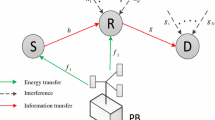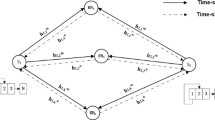Abstract
In future wireless mobile networks, data rate and quality of service are expected to be comparable to those of wired deployments. To achieve this target, novel architectures must be adopted, successfully countering the disadvantages of the wireless transmission. Inspired by that, cooperative relaying was proposed because of the various gains it introduces to the network. In this work we propose a scheme consisting of multi-mode decode and forward relays facilitating the communication between a base station and a user terminal (UT). By equipping the relays with two interfaces, we can exploit the plethora of the available wireless protocols. Also, instead of performing multi-relay transmissions, we adopt an opportunistic relaying scheme due to its simplicity and outage-optimality. Additionally, we incorporate successive transmissions to improve the spectral efficiency, thus recovering the half-duplex loss in capacity due to the two-hop transmission. However, as inter-relay interference arises from successive transmissions, we propose mitigation techniques through interference cancellation and out-band transmissions using the multi-mode relays. At the same time, an energy-aware mechanism is implemented in the selected relay’s transmission, opting for power reduction, as the channel state information is acquired prior to the signal’s forwarding to the UT. Finally, we give numerical results by comparing the proposed energy-aware multi-mode relaying (EA-MMR) scheme, with two other schemes in terms of average end-to-end capacity, outage probability, delay distribution and power gain.
Similar content being viewed by others
References
Bletsas A., Shin H., Win M. Z. (2007) Cooperative communications with outage-optimal opportunistic relaying. IEEE Transactions on Wireless Communications 6(9): 3450–3460
Laneman J. N., Tse D. N. C., Wornell G. W. (2004) Cooperative diversity in wireless networks: Efficient protocols and outage behavior. IEEE Transactions on Information theory 50(12): 3062–3080
Rankov B., Wittneben A. (2007) Spectral efficient protocols for half-duplex fading relay channels. IEEE Journal on Selected Areas in Communications 25(2): 379–389
Chen X., Zhou Q. F., Siu T., Lau F. C. M. (2011) Asymptotic analysis of opportunistic relaying based on the max-generalized-mean selection criterion. IEEE Transactions on Wireless Communication 10(4): 1050–1057
Xu P., Dai X., Ding Z., Krikidis I. (2011) Approaching MISO upper bound: Design of new wireless cooperative transmission protocols. IEEE Transactions on Wireless Communication 10(8): 2725–2737
Waqar, O., McLernon, D. C., & Ghogho, M. (2009). Performance analysis of non-regenerative opportunistic relaying in Nakagami-m fading. In IEEE International Symposium on Personal, Indoor and Mobile Radio Communications (PIMRC) (pp. 232–233). Tokyo, Japan.
Majhi, S., Qian, H., Xiang, W., Addepalli, S., & Gao, Z. (2011). Analysis of outage probability for opportunistic decode-and-forward relaying network over asymmetric fading channels. In IEEE International Conference on Ubiquitous and Future Networks (ICUFN) (pp. 135–139). Dalian, China.
Kim, J. B., & Kim, D. (2009). Outage probability of opportunistic decode-and-forward relaying with co-channel interferences. In IEEE International Conference on Advanced Communications Technology (ICAT) (pp. 919–922). Gangwon-Do, Korea.
Bletsas A., Dimitriou A. G., Sahalos J. N. (2010) Interference-limited opportunistic relaying with reactive sensing. IEEE Transactions on Wireless Communications 9(1): 14–20
Sun L., Zhang T., Niu H. (2011) Inter-relay interference in two-path digital relaying systems: Detrimental or beneficial?. IEEE Transactions on Wireless Communications 10(8): 2468–2473
Wicaksana, H., Ting, S. H., Ho, C. K., Chin, W. H., & Guan, W. L. (2008). On the diversity order of AF cooperative systems with inter-relay interference cancellation. In IEEE Vehicular Technology Conference Spring (VTC) (pp. 634–638). Marina Bay, Singapore.
Luo C., Gong Y., Zheng F. (2011) Full interference cancelation for two-path relay cooperative networks. IEEE Transactions on Vehicular Technology 60(1): 77–81
Kim, Y., & Choi, W. (2010). Interference cancelation based opportunistic relaying with multiple decode-and-forward relays. In IEEE Vehicular Technology Conference Fall (VTC) (pp. 1–5). Ottawa, Canada.
Khandekar, A., Bhusan, N., Tingfang, J., & Vanghi, V. (2010). LTE-advanced: Heterogeneous networks. In IEEE European Wireless Conference (EW) (pp. 978–982). Lucca, Italy.
Buljore S., Harada H., Filin S., Houze P., Tsagkaris K., Holland O. et al (2009) Architecture and enablers for optimized radio resource usage in heterogeneous wireless access networks: The IEEE 1900.4 working group. IEEE Communications Magazine 47(1): 124–129
Andersson K., Ahlund C. (2011) Optimized access network selection in a combined WLAN/LTE environment. Wireless Personal Communications 61(4): 739–751
Xue, P., Gong, P., Park, J. H., Park, D., & Kim, D. K. (2009). Max-min fairness based radio resource management in fourth generation heterogeneous networks. In IEEE International Symposium on Communications and Information Technology (ISCIT) (208–213). Incheon, Korea.
Magagula, L. A., Chan, H. A., & Falowo, O. E. (2010). Handover coordination with a relay-based design for heterogeneous wireless networks. In IEEE Conference on Local Computer Networks (LCN) (pp. 380–383). Denver, USA.
Gao, Z., Ji, Y., & Liu, F. (2010). Performance analysis of cooperative handover in heterogeneous wireless networks. In IEEE GLOBECOM Workshop on Heterogeneous, Multi-hop Wireless and Mobile Networks (GC Wkshps) (pp. 191–195). Miami, USA.
Correia L.M., Zeller D., Blume O., Ferling D., Jading Y., Godor I. et al (2010) Challenges and enabling technologies for energy aware mobile radio networks. IEEE Communications Magazine, 48(11): 66–72
Palit, R., Ward, P., Singh, A., & Naik, S. (2008). Energy-aware co-operative (ECO) relay-based packet transmission in wireless networks. IEEE Wireless Communications and Networking Conference (WCNC) (pp. 2875–2880). Las Vegas, USA.
Madan R., Mehta N. B., Molisch A. F., Zhang J. (2008) Energy-efficient cooperative relaying over fading channels with simple relay selection. IEEE Transactions on Wireless Communications 7(8): 3013–3025
Lee, C. Y., & Hwang, G. U. (2010). Minimum energy consumption design of a two-hop relay network for QoS guarantee. In IEEE Wireless Telecommunications Symposium (WTS) (pp. 1–6). Tampa, USA.
Mehta N. B., Sharma V., Bansal G. (2011) Performance analysis of a cooperative system with rateless codes and buffered relays. IEEE Transactions on Wireless Communications 10(4): 1069–1081
Hwang, Y. T., Tsai, C. Y., & Lin, C. C. (2005). Block-wise adaptive modulation for OFDM WLAN systems. IEEE International Symposium on Circuits and Systems (ISCAS) (pp. 6098–6101). Kobe, Japan.
Yu, C., Xiangming, W., Xinqi, L., & Wei, Z. (2009). Research on the modulation and coding scheme in LTE TDD wireless network. In IEEE International Conference on Industrial Mechatronics and Automation (ICIMA) (pp. 468–471). Chengdu, China.
3GPP TR 25.913. (2010). Requirements for evolved UTRA (E-UTRA) and evolved UTRAN (E-UTRAN) (pp. 1–20).
Author information
Authors and Affiliations
Corresponding author
Rights and permissions
About this article
Cite this article
Nomikos, N., Skoutas, D.N., Vouyioukas, D. et al. Capacity Maximization through Energy-Aware Multi-Mode Relaying. Wireless Pers Commun 74, 83–99 (2014). https://doi.org/10.1007/s11277-012-0899-5
Published:
Issue Date:
DOI: https://doi.org/10.1007/s11277-012-0899-5




